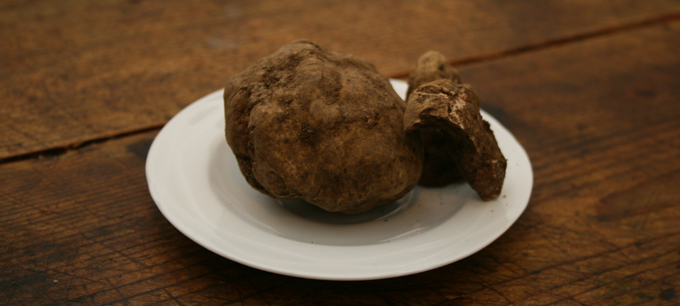A Question of Nose: truffle hunting

Truffle has been known since antiquity as a fruit of the earth. There is evidence of its presence in the diet of the Sumerians and in the time of the patriarch Jacob around 1700-1600 B. C. The ancient Sumerians used the truffle, mixing it with barley, chickpeas, lentils and mustard.
In Tuscany the prestigious White Truffle is found in the areas of the Crete Senesi, from San Giovanni d’Asso to Pienza and from Monteriggioni to San Casciano dei Bagni.
It contains a very high percentage of water and mineral salts absorbed from the soil through the roots of the tree with which it lives in symbiosis. It is born and grows mainly near the roots of the poplar, linden, oak and willow becoming an authentic parasite.
The characteristics of the colour, taste and smell of truffles are determined by the type of tree near which it grows. The truffles, for example, which grow in the vicinity of the oak will have a more concentrated smell while those near lindens will be brighter and aromatic. Their shape depends, however, on the type of soil: if it is soft, the truffle will look smoother; if compact, it will become gnarled and lumpy due to the difficulty of finding room to grow. The man who dedicates his time to the search for this precious tuber, accompanied by his dog for which there can be no substitute, by experience and a little good luck, is called a “tartufaio”.
To experience the unique search for the truffle in San Casciano dei Bagni, Gianni Barzi, of the Biological Farm “Il Bulgherino” offers this possibility, and also gives guided visits to his farm.
The gourmet with his passion for fine food receives a shock and is overcome with joy when he can drown in the intense perfume of the truffle. Appreciated for its aroma and characteristic taste, like other foods, it also has nutritional value.
While for the botanist there are very few differences between the white and black truffle, in the kitchen the two types are neatly differentiated according to an essential principle: the black truffle is eaten in greater quantities while the white one is used for aromatic purposes, transmitting its aroma to food and therefore used in small doses. The black truffle is eaten when cooked whereas the white truffle is almost exclusively eaten raw and sliced with the appropriate truffle slicer directly onto the food.